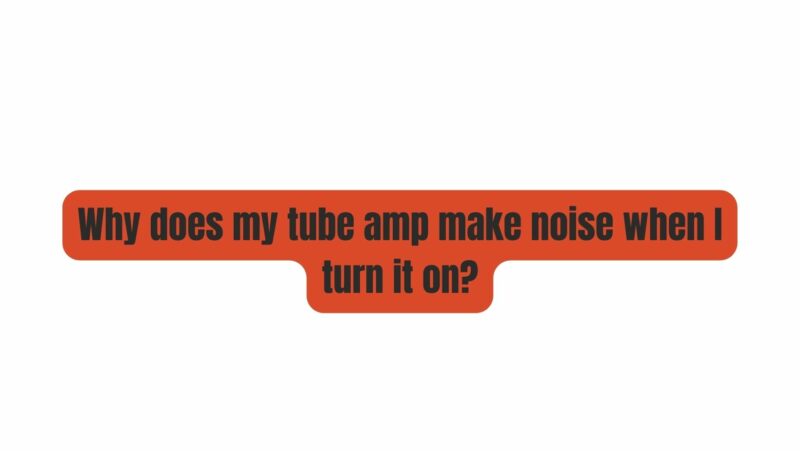Tube amplifiers have a certain allure that captivates musicians and audiophiles alike. They’re renowned for their warm, harmonically rich tones that add a unique character to any audio signal. However, tube amps often exhibit quirks that can be perplexing, especially to those new to the world of vacuum tubes. One such quirk is the noise that can emanate from a tube amp when it’s powered on. In this article, we’ll delve into the fascinating world of tube amp startup noises, exploring their causes, their impact on the amplifier’s components, and how to manage them effectively.
Understanding the Basics: How Tube Amps Work:
Before we unravel the mysteries of startup noises in tube amplifiers, let’s briefly review how these classic pieces of audio equipment function:
- Amplification via Vacuum Tubes: Tube amplifiers, also known as valve amplifiers, employ vacuum tubes (or electron tubes) to amplify audio signals. These tubes contain electrodes and operate by heating up, emitting electrons, and controlling the flow of these electrons to amplify the incoming signal.
- Warmth and Distortion: Tube amps are renowned for their warm, organic tones and harmonic distortion characteristics that many musicians and audiophiles find appealing. The unique sound they produce is partly attributed to the way vacuum tubes amplify and shape the audio signal.
The Sound of Startup: What’s Normal:
When you power on a tube amp, it’s not uncommon to hear a sequence of sounds that might seem unusual, especially if you’re more accustomed to solid-state amplifiers. Here are some typical startup noises in tube amps:
- Relay Click: Many tube amplifiers have a relay that clicks when the amp is powered on. This relay is often used to delay the connection between the power supply and the high-voltage components, such as the tubes, to protect them from voltage surges during startup.
- Transformer Hum: The power transformer in a tube amp can emit a low-frequency hum when it’s energized. This hum is usually brief and subsides as the transformer stabilizes.
- Tube Glow: As the vacuum tubes heat up, you’ll often see them glow. This is entirely normal and is a characteristic feature of tube amplifiers. It’s also part of what gives them their unique visual appeal.
- Warm-Up Time: Some tube amps may take a few seconds to minutes to reach their optimal operating temperature. During this time, you might hear slight variations in sound as the tubes warm up and stabilize.
While these startup noises are generally considered normal, they are not the only sounds you might encounter when powering on a tube amp.
The Variety of Startup Noises: Causes and Explanations:
- Pop or Click: A sudden pop or click sound when you turn on your tube amp is often related to the amplifier’s relay. As mentioned earlier, the relay is used to protect sensitive components from voltage surges. The clicking sound is the relay engaging to connect the power supply to the high-voltage components.
- Transformer Hum: Transformer hum is another common noise during startup. It occurs as the transformer’s core and windings adjust to the sudden flow of current. Once the transformer stabilizes, the hum usually subsides.
- Minor Crackling: Some minor crackling or hissing sounds during startup can be attributed to the heating process of the vacuum tubes. As they heat up, residual gases inside the tubes are expelled, creating these sounds. It’s often more noticeable in older tubes or those that haven’t been used for a while.
- Tube Rattles: In rare cases, tubes with loose internal components may produce rattling or buzzing sounds during startup. This is a sign that the tube might be microphonic and could benefit from replacement.
When to Be Concerned: Abnormal Startup Noises:
While many startup noises in tube amps are normal, there are situations when you should be concerned:
- Loud Pops or Bangs: If your amp emits a loud, explosive sound during startup, it could indicate a serious issue. This might be due to a short circuit, a component failure, or a faulty relay.
- Persistent Hum or Buzz: If the transformer hum or other noises persist indefinitely and don’t subside, it could signal a problem with the power supply or other components.
- Tube Red Plating: If you see one or more tubes glowing excessively bright, especially with a red or purple hue, this is called “red plating.” It indicates a severe issue with the tube and should be addressed immediately.
- Odor or Smoke: If you detect unusual odors or see smoke emanating from your amp during startup, power it down immediately and seek professional repair.
Managing Startup Noises: Tips and Best Practices:
- Warm-Up Time: Give your tube amp a few minutes to warm up before expecting optimal performance. During this time, it’s normal to hear slight variations in sound.
- Regular Maintenance: Maintain your amp by ensuring tubes are securely seated in their sockets, checking for loose connections, and keeping it clean.
- Tube Replacement: If you encounter persistent noises, especially in older amplifiers or with tubes that have seen a lot of use, consider replacing the tubes. This can often resolve startup noise issues.
- Professional Inspection: If you’re unsure about the source of startup noises or encounter abnormal sounds, it’s advisable to have your amp inspected by a qualified technician.
Conclusion: The Sonic Symphony of Tube Amp Startup:
In the world of tube amplifiers, the noises heard during startup are part of the charm and character that endears these amplifiers to musicians and audiophiles. Understanding the causes of these noises, differentiating between normal and abnormal sounds, and taking appropriate measures for maintenance and repair can help ensure that your tube amp continues to produce the sweet, harmonically rich tones it’s celebrated for. Embrace the symphony of startup noises, and let them be a reminder of the magic happening inside your amplifier every time you power it on.


